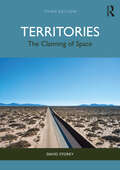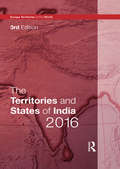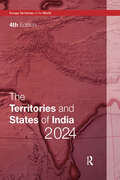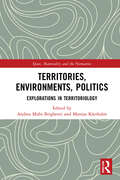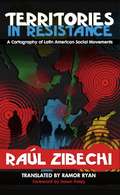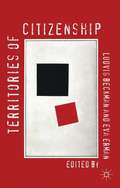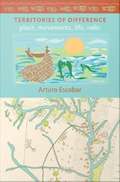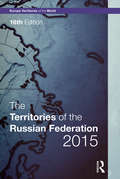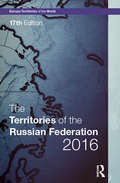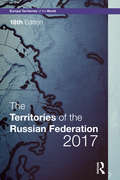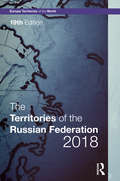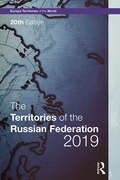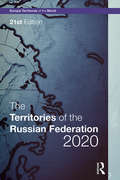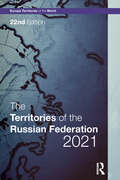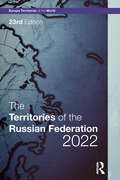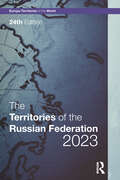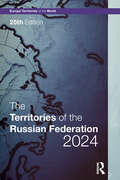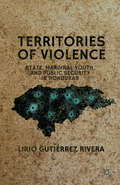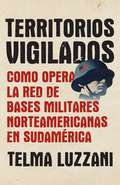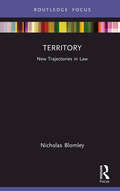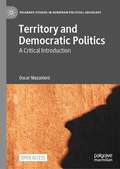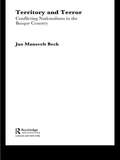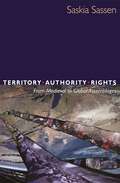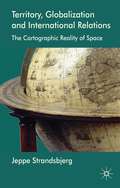- Table View
- List View
Territories: The Claiming of Space
by David StoreyTerritories are more than simply bounded spaces; they reflect the ways in which we think of geographic space. Territoriality, or laying claim to territory, can be seen as the spatial expression of power, with borders dividing those inside from those outside. The book provides an introduction to the concept of territory, the ways in which ideologies and social practices are manifested in space, the deployment of territorial strategies and the geographical outcomes of these.This revised and updated third edition focuses on both macro-scale examples and those less obvious micro-scale ones, and it explores how territorial strategies are used in the maintaining of power, or as a means of resistance. Throughout the book, key questions emerge concerning geographic space. Who is "allowed" to be in particular spaces and who is excluded or discouraged from being there? How are territorial practices utilised in conflicts concerned with socio-political power and identity and how are ideologies transposed onto space?Written from a geographical perspective, the book is interdisciplinary, drawing on ideas and material from a range of academic disciplines including history, political science, sociology, international relations, and cultural studies. Theoretical underpinnings are supported by a variety of historical and contemporary examples, drawn from a range of geographic contexts.
The Territories and States of India 2016
by Europa PublicationsThis invaluable collection of information provides an in-depth guide to the regional dimension of the politics and economy of this vast and complex country. Incomparable in its coverage, which includes a detailed chronology for India as a whole, a bibliography, contact details for leading officials, and an historical account and economic survey for each of the twenty-nine states and seven territories, it supplies the reader with a more complete understanding of India as a whole.
The Territories and States of India 2024 (Europa Territories of the World series)
by Meena KhanThis invaluable collection of information provides an in-depth guide to the regional dimension of the politics and economy of this vast and complex country. Incomparable in its coverage, which includes a detailed chronology for India as a whole, a bibliography, contact details for leading officials, and an historical account and economic survey for each of the twenty-nine states and seven territories, it supplies the reader with a more complete understanding of India as a whole.
Territories, Environments, Politics: Explorations in Territoriology
by Andrea Mubi BrighentiThis collection seeks to illustrate the state of the art in territoriological research, both empirical and theoretical. The volume gathers together a series of original, previously unpublished essays exploring the newly emerging territorial formations in culture, politics and society. While the globalisation debate of the 1990s largely pivoted around a ‘general deterritorialisation’ hypothesis, since the 2000s it has become apparent that, rather than effacing territories, global connections are added to them, and represent a further factor in the increase of territorial complexity. Key questions follow, such as: How can we further the knowledge around territorial complexities and the ways in which different processes of territorialisation co-exist and interact, integrating scientific advances from a plurality of disciplines? Where and what forms does territorial complexity assume, and how do complex territories operate in specific instances? Which technological, political and cultural facets of territories should be tackled to make sense of the life of territories? How and by what different or combined methods can we describe territories, and do justice to their articulations and meanings? How can the territoriological vocabulary relate to contemporary social theory advancements such as ANT, the ontological turn, the mobilities paradigm, sensory urbanism, and atmospheres research? How can territorial phenomena be studied across disciplinary boundaries? Territories, Environments, Politics casts a fresh perspective onto a number of key contemporary socio-spatial phenomena. Refraining from the attempt to ossify territoriology into some disciplinary straightjacket, the collection aims to illustrate the scope of current territoriological research, its domain, its promises, its theoretical advancements, and its methodological reflection in the making. Scholars interested in social research will find in this collection a rich and imaginative theoretical-methodological toolkit. Students in human geography, anthropology and sociology, socio-legal studies, architecture and urban planning will find Territories, Environments, Politics of interest.
Territories in Resistance
by Raul Zibechi Ramor Ryan"Rich and complicated . . . [Territories in Resistance] will be a key reference point in the development of anti-systemic thought."--Gilberto López y Rivas, La Jornada Territories in Resistance is an indispensable complement to existing literature on Latin American autonomous social movements. Explore the "other worlds" being created in the wreckage of colonialism and capitalism. From Mexico, Ecuador, and Colombia to Argentina and Brazil, no living author digs as deep and presents theoretical challenges quite like Raúl Zibechi. Raúl Zibechi is an international analyst for Brecha, a weekly journal in Montevideo, Uruguay, and the author of Dispersing Power: Social Movements as Anti-State Forces (AK Press, 2010).
Territories of Citizenship
by Ludvig Beckman Eva ErmanA comprehensive exploration of theories of citizenship and inclusiveness in an age of globalization. The authors analyze democracy and the political community in a transnational context, using new critical, conceptual and normative perspectives on the borders, territories and political agents of the state.
Territories of Difference: Place, Movements, Life, Redes
by Arturo EscobarIn Territories of Difference, Arturo Escobar, author of the widely debated book Encountering Development, analyzes the politics of difference enacted by specific place-based ethnic and environmental movements in the context of neoliberal globalization. His analysis is based on his many years of engagement with a group of Afro-Colombian activists of Colombia's Pacific rainforest region, the Proceso de Comunidades Negras (PCN). Escobar offers a detailed ethnographic account of PCN's visions, strategies, and practices, and he chronicles and analyzes the movement's struggles for autonomy, territory, justice, and cultural recognition. Yet he also does much more. Consistently emphasizing the value of local activist knowledge for both understanding and social action and drawing on multiple strands of critical scholarship, Escobar proposes new ways for scholars and activists to examine and apprehend the momentous, complex processes engulfing regions such as the Colombian Pacific today. Escobar illuminates many interrelated dynamics, including the Colombian government's policies of development and pluralism that created conditions for the emergence of black and indigenous social movements and those movements' efforts to steer the region in particular directions. He examines attempts by capitalists to appropriate the rainforest and extract resources, by developers to set the region on the path of modernist progress, and by biologists and others to defend this incredibly rich biodiversity "hot-spot" from the most predatory activities of capitalists and developers. He also looks at the attempts of academics, activists, and intellectuals to understand all of these complicated processes. Territories of Difference is Escobar's effort to think with Afro-Colombian intellectual-activists who aim to move beyond the limits of Eurocentric paradigms as they confront the ravages of neoliberal globalization and seek to defend their place-based cultures and territories.
The Territories of Indonesia
by Iem BrownA new addition to Europa's popular 'Territories of the World' series, The Territories of Indonesia provides invaluable information on this diverse country. The book supplies an in-depth guide to both the regional dimensions of the area and its inter-provincial politics. Key Features: informative introductory essays provide an impartial background on regional aspects of the Republic a chronology covers the major events in the area's political and economic history including: colonial rule, independence, guided democracy, Suharto and recent terrorist activities information is provided about the national governments, structures and organizations. Individual chapters on each of the provinces and special districts, providing: a map of the area, with geographical and historical information an economic survey presenting the latest available statistics on performance and conditions in each of the provinces and districts a directory of the names and addresses of leading administrative and political officials. This key publication offers a unique insight into the relationship between provinces and central government within Indonesia.
The Territories of the Russian Federation 2015
by Europa PublicationsThis excellent reference source brings together hard-to-find information on the constituent units of the Russian Federation. The introduction examines the Russian Federation as a whole, focusing on Russian federalism and elections, followed by a chronology, demographic and economic statistics, and a review of the Federal Government. The second section comprises territorial surveys, each of which includes a current map. This edition includes new surveys covering the recently annexed (and disputed) territories of Crimea and Sevastopol, as well as updated surveys of each of the other 83 federal subjects. The third section comprises a select bibliography of books. The fourth section features a series of indexes, listing the territories alphabetically, by Federal Okrug and Economic Area. Users will also find a gazetteer of selected alternative and historic names, a list of the territories abolished, created or reconstituted in the post-Soviet period, and an index of more than 100 principal cities, detailing the territory in which each is located.
The Territories of the Russian Federation 2016
by Europa PublicationsThis excellent reference source brings together hard-to-find information on the constituent units of the Russian Federation. The introduction examines the Russian Federation as a whole, followed by a chronology, demographic and economic statistics, and a review of the Federal Government. The second section comprises territorial surveys, each of which includes a current map. This edition includes surveys covering the annexed (and disputed) territories of Crimea and Sevastopol, as well as updated surveys of each of the other 83 federal subjects. The third section comprises a select bibliography of books. The fourth section features a series of indexes, listing the territories alphabetically, by Federal Okrug and Economic Area. Users will also find a gazetteer of selected alternative and historic names, a list of the territories abolished, created or reconstituted in the post-Soviet period, and an index of more than 100 principal cities, detailing the territory in which each is located.
The Territories of the Russian Federation 2017
by 18th EditionThis excellent reference source brings together hard-to-find information on the constituent units of the Russian Federation. The introduction examines the Russian Federation as a whole, followed by a chronology, demographic and economic statistics, and a review of the Federal Government. The second section comprises territorial surveys, each of which includes a current map. This edition includes surveys covering the annexed (and disputed) territories of Crimea and Sevastopol, as well as updated surveys of each of the other 83 federal subjects. The third section comprises a select bibliography of books. The fourth section features a series of indexes, listing the territories alphabetically, by Federal Okrug and Economic Area. Users will also find a gazetteer of selected alternative and historic names, a list of the territories abolished, created or reconstituted in the post-Soviet period, and an index of more than 100 principal cities, detailing the territory in which each is located.
The Territories of the Russian Federation 2018
by Europa PublicationsThis excellent reference source brings together hard-to-find information on the constituent units of the Russian Federation. The introduction examines the Russian Federation as a whole, followed by a chronology, demographic and economic statistics, and a review of the Federal Government. The second section comprises territorial surveys, each of which includes a current map. This edition includes surveys covering the annexed (and disputed) territories of Crimea and Sevastopol, as well as updated surveys of each of the other 83 federal subjects. The third section comprises a select bibliography of books. The fourth section features a series of indexes, listing the territories alphabetically, by Federal Okrug and Economic Area. Users will also find a gazetteer of selected alternative and historic names, a list of the territories abolished, created or reconstituted in the post-Soviet period, and an index of more than 100 principal cities, detailing the territory in which each is located.
The Territories of the Russian Federation 2019
by Europa PublicationsThis excellent reference source brings together hard-to-find information on the constituent units of the Russian Federation. The introduction examines the Russian Federation as a whole, followed by a chronology, demographic and economic statistics, and a review of the Federal Government. The second section comprises territorial surveys, each of which includes a current map. This edition includes surveys covering the annexed (and disputed) territories of Crimea and Sevastopol, as well as updated surveys of each of the other 83 federal subjects. The third section comprises a select bibliography of books. The fourth section features a series of indexes, listing the territories alphabetically, by Federal Okrug and Economic Area. Users will also find a gazetteer of selected alternative and historic names, a list of the territories abolished, created or reconstituted in the post-Soviet period, and an index of more than 100 principal cities, detailing the territory in which each is located.
The Territories of the Russian Federation 2020
by Europa Europa PublicationsThis excellent reference source brings together hard-to-find information on the constituent units of the Russian Federation. The introduction examines the Russian Federation as a whole, followed by a chronology, demographic and economic statistics, and a review of the Federal Government. The second section comprises territorial surveys, each of which includes a current map. This edition includes surveys covering the annexed (and disputed) territories of Crimea and Sevastopol, as well as updated surveys of each of the other 83 federal subjects. The third section comprises a select bibliography of books. The fourth section features a series of indexes, listing the territories alphabetically, by Federal Okrug and Economic Area. Users will also find a gazetteer of selected alternative and historic names, a list of the territories abolished, created or reconstituted in the post-Soviet period, and an index of more than 100 principal cities, detailing the territory in which each is located.
The Territories of the Russian Federation 2021
by Dominic HeaneyThis excellent reference source brings together hard-to-find information on the constituent units of the Russian Federation. The introduction examines the Russian Federation as a whole, followed by a chronology, demographic and economic statistics, and a review of the Federal Government. The second section comprises territorial surveys, each of which includes a current map. This edition includes surveys covering the annexed (and disputed) territories of Crimea and Sevastopol, as well as updated surveys of each of the other 83 federal subjects. The third section comprises a select bibliography of books. The fourth section features a series of indexes, listing the territories alphabetically, by Federal Okrug and Economic Area. Users will also find a gazetteer of selected alternative and historic names, a list of the territories abolished, created or reconstituted in the post-Soviet period, and an index of more than 100 principal cities, detailing the territory in which each is located.
The Territories of the Russian Federation 2022
by Dominic HeaneyThis excellent reference source brings together hard-to-find information on the constituent units of the Russian Federation. The introduction examines the Russian Federation as a whole, followed by a chronology, demographic and economic statistics, and a review of the Federal Government. The second section comprises territorial surveys, each of which includes a current map. This edition includes surveys covering the annexed (and disputed) territories of Crimea and Sevastopol, as well as updated surveys of each of the other 83 federal subjects. The third section comprises a select bibliography of books. The fourth section features a series of indexes, listing the territories alphabetically, by Federal Okrug and Economic Area. Users will also find a gazetteer of selected alternative and historic names, a list of the territories abolished, created or reconstituted in the post-Soviet period, and an index of more than 100 principal cities, detailing the territory in which each is located.
The Territories of the Russian Federation 2023 (Europa Territories Of The World Ser.)
by Dominic HeaneyThis excellent reference source brings together hard-to-find information on the constituent units of the Russian Federation. The introduction examines the Russian Federation as a whole, followed by a chronology, demographic and economic statistics, and a review of the Federal Government. The second section comprises territorial surveys, each of which includes a current map. This edition includes surveys covering the annexed (and disputed) territories of Crimea and Sevastopol, as well as updated surveys of each of the other 83 federal subjects. The third section comprises a select bibliography of books. The fourth section features a series of indexes, listing the territories alphabetically, by Federal Okrug and Economic Area. Users will also find a gazetteer of selected alternative and historic names, a list of the territories abolished, created or reconstituted in the post-Soviet period, and an index of more than 100 principal cities, detailing the territory in which each is located.
The Territories of the Russian Federation 2024 (Europa Territories of the World series)
This excellent reference source brings together hard-to-find information on the constituent units of the Russian Federation.The introduction examines the Russian Federation as a whole, followed by a chronology, demographic and economic statistics, and a review of the Federal Government. The second section comprises territorial surveys, each of which includes a current map. This edition includes surveys covering the annexed (and disputed) territories of Crimea and Sevastopol, as well as updated surveys of each of the other 83 federal subjects. The third section comprises a select bibliography of books. The fourth section features a series of indexes, listing the territories alphabetically, by Federal Okrug and Economic Area. Users will also find a gazetteer of selected alternative and historic names, a list of the territories abolished, created or reconstituted in the post-Soviet period, and an index of more than 100 principal cities, detailing the territory in which each is located.
Territories of Violence
by Lirio Gutiérrez RiveraThis book examines the persistence of social violence and public insecurity in Honduras. Using a spatial perspective, the author looks at the Honduran state's security polices - known as Mano Dura - and the challenges authorities face. She points to the state's historical difficulty producing and ordering political territory and space.
Territorios vigilados: Como opera la red de bases militares norteamericanas en Sudamérica
by Telma Luzzani¿Por qué siempre fue vital para los Estados Unidos contar con una red debases militares que garantizara el control político y económico denuestra región y evitara, a su vez, todo intento de integración oautonomía? Cada tanto una noticia nos sobresalta. «La IV Flota patrulla aguassudamericanas», «E.E.U.U. busca instalar una base militar en el Chaco» o«entrena tropas en la base chilena de Concón». Enseguida aparecenversiones tranquilizadoras: «No hay de qué preocuparse, son misioneshumanitarias». Este libro surgió de la evidencia de ese doble discurso.A fines de 2009, Colombia, bajo el gobierno de Álvaro Uribe, autorizó alPentágono a ocupar siete bases militares de su país; desde hacía un añola IV Flota patrullaba nuestros océanos y cada vez había más señales deque Estados Unidos avanzaba militarmente sobre América del Sur. El viejomito de que nuestro subcontinente no está en la agenda de la Casa Blancacaía por tierra. ¿Para qué Norteamérica necesita avanzar con una fuerzade tal magnitud sobre una zona claramente desmilitarizada? El comercio,los recursos naturales y la necesidad de mantener su hegemonía en unsiglo XXI muy convulso son parte de la respuesta. En ese esquema, lospasos interoceánicos de Panamá, el Estrecho de Magallanes y el Pasaje deDrake (de ahí la importancia de las Islas Malvinas) se han vuelto clave.La autora indaga además las formas discursivas que utiliza el imperiopara minimizar el peligro de esa presencia militar. Se trata de unainvestigación original e inquietante, necesaria para comprender elpasado y transformar el futuro de nuestro continente.
Territory: New Trajectories in Law (New Trajectories in Law)
by Nicholas BlomleyThis book introduces readers to the concept of territory as it applies to law while demonstrating the particular work that territory does in organizing property relations. Territories can be found in all societies and at all scales, although they take different forms. The concern here is on the use of territories in organizing legal relations. Law, as a form of power, often works through a variety of territorial strategies, serving multiple legal functions, such as attempts at creating forms of desired behaviour. Landed property, in Western society, is often highly territorial, reliant on sharply policed borders and spatial exclusion. But rather than thinking of territory as obvious and given or as a natural phenomenon, this book focuses particularly on its relation to property to argue that territory is both a social product, and a specific technology that organizes social relations. That is: territory is not simply an outcome of property relations but a strategic means by which such relations are communicated, imagined, legitimized, enforced, naturalized and contested. Accessible to students, this book will be of interest to those working in the areas of sociolegal studies, geography, urban studies, and politics.
Territory and Democratic Politics: A Critical Introduction (Palgrave Studies in European Political Sociology)
by Oscar MazzoleniThe book provides a comprehensive and updated introduction to concept of territory in the study of democratic politics. Territory plays a rather marginal role in the traditional conceptions of democracy that in many ways still prevail today. Democratic politics is often analysed from the point of view of its institutions, citizens and voters, while little is said about the territory through which it is expressed – at most it provides a broader perimeter or context of political and institutional action. The book offers, instead, an introductory theoretically-oriented discussion of crucial issues such as the genesis of state-nation, the transformation of democratic citizenship, the current borders’ policies, the rising of territorial populism and the experience of 19-covid pandemic.This is an open access book.
Territory and Terror: Conflicting Nationalisms in the Basque Country (Routledge Advances in European Politics #Vol. 25)
by Jan Mansvelt BeckAll Basque interpretations of national power have resulted in an uneasy mix of often fragmented and conflicting territorial identifications. Basques can identify themselves with France, Spain or an imagined Basque nation state. Territory and Terror confronts the imagined and actual territorial dimensions of nationalism, shedding new light on the Basque conflict. The study provides a rich description of territoriality analysed from a comparative perspective and explores the relation between territoriality and regional differences in conflict intensity. It supplies an account of the oft-overlooked internal struggles between Basques, arguing that overestimation of Basque nationalism as the ideological force behind the conflict often leads to a disregard of the identification of many with France or Spain. In addition, the author investigates the conflicts between Basque nationalists themselves over key issues such as terrorist activity. Territory and Terror will appeal to students and researchers of nationalism and territoriality, in particular to those with an interest in the Basque country.
Territory, Authority, Rights: From Medieval to Global Assemblages
by Saskia SassenWhere does the nation-state end and globalization begin? In Territory, Authority, Rights, one of the world's leading authorities on globalization shows how the national state made today's global era possible. Saskia Sassen argues that even while globalization is best understood as "denationalization," it continues to be shaped, channeled, and enabled by institutions and networks originally developed with nations in mind, such as the rule of law and respect for private authority. This process of state making produced some of the capabilities enabling the global era. The difference is that these capabilities have become part of new organizing logics: actors other than nation-states deploy them for new purposes. Sassen builds her case by examining how three components of any society in any age--territory, authority, and rights--have changed in themselves and in their interrelationships across three major historical "assemblages": the medieval, the national, and the global. The book consists of three parts. The first, "Assembling the National," traces the emergence of territoriality in the Middle Ages and considers monarchical divinity as a precursor to sovereign secular authority. The second part, "Disassembling the National," analyzes economic, legal, technological, and political conditions and projects that are shaping new organizing logics. The third part, "Assemblages of a Global Digital Age," examines particular intersections of the new digital technologies with territory, authority, and rights. Sweeping in scope, rich in detail, and highly readable, Territory, Authority, Rights is a definitive new statement on globalization that will resonate throughout the social sciences.
Territory, Globalization and International Relations
by Jeppe StrandsbjergGlobalization and changes to statehood challenge our understanding of space and territory. This book argues that we must understand that both the modern state and globalisation are based on a cartographic reality of space. In consequence, claims that globalization represents a spatial challenge to state territory are deeply problematic.
